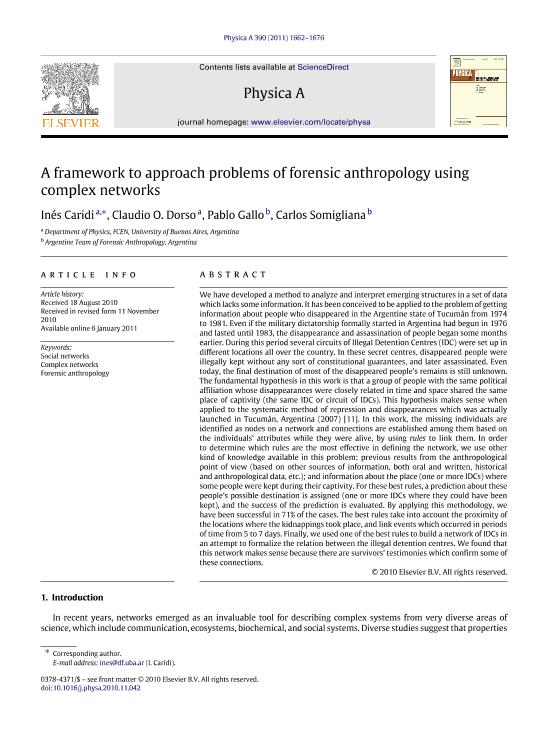Mostrar el registro sencillo del ítem
dc.contributor.author
Caridi, Délida Inés

dc.contributor.author
Dorso, Claudio Oscar

dc.contributor.author
Gallo, Pablo
dc.contributor.author
Somigliana, Carlos
dc.date.available
2019-06-13T16:10:57Z
dc.date.issued
2011-05
dc.identifier.citation
Caridi, Délida Inés; Dorso, Claudio Oscar; Gallo, Pablo; Somigliana, Carlos; A framework to approach problems of forensic anthropology using complex networks; Elsevier Science; Physica A: Statistical Mechanics and its Applications; 390; 9; 5-2011; 1662-1676
dc.identifier.issn
0378-4371
dc.identifier.uri
http://hdl.handle.net/11336/78212
dc.description.abstract
We have developed a method to analyze and interpret emerging structures in a set of data which lacks some information. It has been conceived to be applied to the problem of getting information about people who disappeared in the Argentine state of Tucumn from 1974 to 1981. Even if the military dictatorship formally started in Argentina had begun in 1976 and lasted until 1983, the disappearance and assassination of people began some months earlier. During this period several circuits of Illegal Detention Centres (IDC) were set up in different locations all over the country. In these secret centres, disappeared people were illegally kept without any sort of constitutional guarantees, and later assassinated. Even today, the final destination of most of the disappeared people's remains is still unknown. The fundamental hypothesis in this work is that a group of people with the same political affiliation whose disappearances were closely related in time and space shared the same place of captivity (the same IDC or circuit of IDCs). This hypothesis makes sense when applied to the systematic method of repression and disappearances which was actually launched in Tucumn, Argentina (2007) [11]. In this work, the missing individuals are identified as nodes on a network and connections are established among them based on the individuals' attributes while they were alive, by using rules to link them. In order to determine which rules are the most effective in defining the network, we use other kind of knowledge available in this problem: previous results from the anthropological point of view (based on other sources of information, both oral and written, historical and anthropological data, etc.); and information about the place (one or more IDCs) where some people were kept during their captivity. For these best rules, a prediction about these people's possible destination is assigned (one or more IDCs where they could have been kept), and the success of the prediction is evaluated. By applying this methodology, we have been successful in 71% of the cases. The best rules take into account the proximity of the locations where the kidnappings took place, and link events which occurred in periods of time from 5 to 7 days. Finally, we used one of the best rules to build a network of IDCs in an attempt to formalize the relation between the illegal detention centres. We found that this network makes sense because there are survivors' testimonies which confirm some of these connections. © 2011 Elsevier B.V. All rights reserved.
dc.format
application/pdf
dc.language.iso
eng
dc.publisher
Elsevier Science

dc.rights
info:eu-repo/semantics/openAccess
dc.rights.uri
https://creativecommons.org/licenses/by-nc-sa/2.5/ar/
dc.subject
Complex Networks
dc.subject
Forensic Anthropology
dc.subject
Social Networks
dc.title
A framework to approach problems of forensic anthropology using complex networks
dc.type
info:eu-repo/semantics/article
dc.type
info:ar-repo/semantics/artículo
dc.type
info:eu-repo/semantics/publishedVersion
dc.date.updated
2019-06-07T14:06:41Z
dc.journal.volume
390
dc.journal.number
9
dc.journal.pagination
1662-1676
dc.journal.pais
Países Bajos

dc.journal.ciudad
Amsterdam
dc.description.fil
Fil: Caridi, Délida Inés. Universidad de Buenos Aires. Facultad de Ciencias Exactas y Naturales. Departamento de Física; Argentina. Consejo Nacional de Investigaciones Científicas y Técnicas. Oficina de Coordinación Administrativa Ciudad Universitaria. Instituto de Física de Buenos Aires. Universidad de Buenos Aires. Facultad de Ciencias Exactas y Naturales. Instituto de Física de Buenos Aires; Argentina
dc.description.fil
Fil: Dorso, Claudio Oscar. Universidad de Buenos Aires. Facultad de Ciencias Exactas y Naturales. Departamento de Física; Argentina. Consejo Nacional de Investigaciones Científicas y Técnicas. Oficina de Coordinación Administrativa Ciudad Universitaria. Instituto de Física de Buenos Aires. Universidad de Buenos Aires. Facultad de Ciencias Exactas y Naturales. Instituto de Física de Buenos Aires; Argentina
dc.description.fil
Fil: Gallo, Pablo. Argentine Team of Forensic Anthropology; Argentina
dc.description.fil
Fil: Somigliana, Carlos. Argentine Team of Forensic Anthropology; Argentina
dc.journal.title
Physica A: Statistical Mechanics and its Applications

dc.relation.alternativeid
info:eu-repo/semantics/altIdentifier/url/http://www.sciencedirect.com/science/article/pii/S037843711001006X
dc.relation.alternativeid
info:eu-repo/semantics/altIdentifier/doi/http://dx.doi.org/10.1016/j.physa.2010.11.042
Archivos asociados
